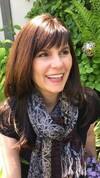Anita Fitch Pazner

Anita Fitch Pazner lives in Michigan with her husband, Bruce, and a needy Portuguese water dog named Finn. She has a degree in journalism from Oakland University and an MFA in Writing for Children and Young Adults from the Vermont College of Fine Arts. A lifelong learner, she also earned a master’s degree in gardening from Michigan State University, so she could write a gardening column for a local newspaper. This is her first children’s book.
Interview
What was your favorite book when you were a child?
One of my favorite childhood books was Frederick by author/illustrator Leo Lionni. It’s a lovely story about a family of field mice preparing for winter. Each mouse has a job collecting food and supplies—everyone except Fredrick. He feels his job is to catch the sun’s rays, the colors of summer, and the dreams, thoughts, and words to sustain the family’s spirits through the cold, dark winter months. Frederick was a poet, and even though he didn’t follow the traditional tasks of preparing for winter, his job turned out to be just as important as everyone else’s. When I got a little older, I loved Summer of My German Soldier, written by Bette Greene. It’s a story about a twelve-year-old Jewish girl named Patty Bergen living in Jenkinsville, Arkansas, during World War II. This story continues to speak to me to this day. In fact, it was the inspiration for my critical thesis in my master’s program, where I discussed the need for an ambiguous approach to good and evil in children’s literature. At face value, a captured German soldier imprisoned in a small town in Arkansas seems like a straightforward villain. On further inspection, evil lurked closer to home for Patty Bergen. This book discusses racism, anti-Semitism, and domestic abuse, while still managing to warm a reader’s heart by showing us that love and kindness often come from unexpected places.
What’s your favorite line from a book?
“Stories,” he’d said, his voice low and almost husky, “we are made up of stories. And even the ones that seem the most like lies can be our deepest hidden truths. –Jane Yolen (Briar Rose)
Who are your top three favorite authors or illustrators?
That’s a tough one. I’m part of an incredible community of writers and illustrators. I can give you a group of three writers who inspired me by tackling some deep topics in children’s literature. They are Jane Yolen, Patricia Polacco, and Bette Greene. I can’t imagine where we would be without them. As for my favorites—how much time do you have? I’ve spent the last decade reading as many books as I can get my hands on, and I studied with so many accomplished author/teachers and fellow students. It’s like asking me to list my favorite children. I love them all equally, but differently. And honestly, it depends on the day.
Why did you want to become an author or illustrator?
This is an easy question. I always wanted to draw and write. I received my first diary before I could spell. It was purple. It had a lock and a key. I held on to it until I thought I knew enough words to write beautiful sentences and draw flowers, trees, dragons, and a girl who could fight all the bad things in the world with her trusty steed (usually in the form of a cat or dog) at her side and a magic sword in her hands. I still draw and paint with watercolors, but I leave the illustrating to those who have spent their lives perfecting their craft.
Do you have any advice for future authors or illustrators?
I do. Read, read, and read some more. Study each book you can get your hands on and take classes. Hone your craft. Approach writing and illustrating as if it were not only a passion but also a job, a business, and a career because it is. No one ever said they wanted to be a neurosurgeon in their spare time. Take your writing seriously even when others don’t. If you want to write lyrically—read poetry and get a copy of Ursula LeGuin’s Steering the Craft: A Twenty-First Century Guide to Sailing the Sea of Story. Adding a musical quality to my writing was always one of my goals. I began my writing career working for newspapers and magazines where there wasn’t room for pretty words, so I didn’t learn how to use them until I intentionally read books by authors who had mastered the process. In fact, my first advisor at VCFA suggested I move on to working on something else, but I was stubborn. I asked him for a list of as many books that fit the description as he could find. He sent me a list of about twenty books to read in a three-week period before my next packet was due. It wasn’t until I discovered Ursula LeGuin’s book that I could write prose that felt beautiful to me and didn’t leave my advisor rubbing his eyes and scratching his head.

